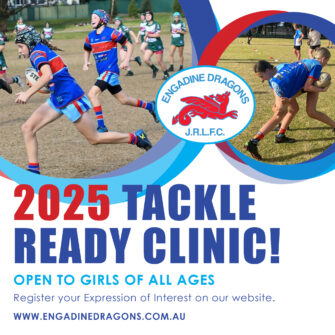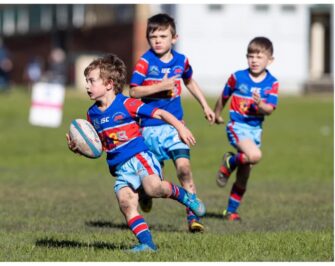Extract from the Engadine District News special edition of 28th June, 1978 on the 21st birthday of the Engadine Dragons Junior Rugby League & Cricket Club.
Although this feature is about the Engadine Dragons Rugby League and Cricket Clubs, this article traces the early history of Rugby League in the Engadine area.
Rugby League is the oldest code of football played in the Engadine area.
The following is quoted from J. E. Thompson’s Engadine History booklet: “The Engadine Junior Rugby League Football Club, which commenced last year (1955) this year took part in the St. George District Competition. The lads are all keen, and the Club should develop well. Their colours are black and gold, and term themselves “The Tigers”. The previous R.L. club formed in the 1930’s played in red and green colours. They did not take part in District competition matches, but rather Inter-District matches. There are many memories of the times Engadine met Heathcote on the Heathcote Playing Field”.
Between the original Rugby League teams in the ’30s and the formation of Engadine United in 1954, the Engadine “Rainbows” kept R.L. to the forefront in the area with regular social matches.
“The “Rainbows” was a name tagged on the side as the team played in a multitude of coloured jerseys. Matches were played against factory teams and against the Heathcote boys. Well-known local identify Ken Beames organised many of these matches.
Engadine United formed in 1954 played social matches that year and the following year entered the competition proper. A new committee was formed in 1955 with John Cooper as President, Denis Thompson as Secretary, and Lance Bartlett as Treasurer. A, B and E grade sides were entered in the competition as Engadine’s representatives. Being short of experienced A grade players the Engadine officials secured the services of ex-St.George grade players “Ossie” Mullins, Harry Williams and Keith West. These players together with local boys Col Keenan, Kevin Macken, Norm McKenzie and John Edmonds made up the nucleus of the team.
Doug de Witt, Alan Jackson, Eddie, Ron and John Burke and Gordon Morrison were just a few of the local boys who represented the Tigers during the formation.
The first year Engadine won only one match as the competition was very strong. The next season, further St. George players in Ron Corps and Ken Laver played, however, the team had not much more success. It was decided at the end of that season to buy a captain-coach, as other teams in the competition had done this with great success.
Former Internationals “Dutchy” Holland, Bruce Hopkins, Johnny Hawke, also Mick Mullane and Matt McCoy former State players, were just a number of the captain-coaches playing with other teams.
The decision to buy a captain-coach resulted in New Zealand player Bill Woolsey being purchased for the season on a fee of £100, two other Kiwis in Ton Bakalich and Jim Miller were also paid to play on a fee of £50 each for the season. Engadine broached the International poaching ban of that time in securing these players and was the first club in Australia to do so. George Crawford, top Daily Telegraph R.L. reporter at that time, in his column “In Touch” devoted his whole article to the Engadine move in securing these players.
The Engadine Club tried to gain a clearance for the N.Z. players, and on application to the N.Z.R.F.L. had secured a reference only and not a clearance. So the Engadine Club of that time printed a letterhead and wrote their own clearance.
23 competition points were gained that year from 10 wins and 2 byes, but the Tigers were unlucky and missed the final four by one point. Coming from the bottom of the competition table to 5th was a very good effort as their were 12 teams playing in the A grade that year.
Many other Kiwis followed their mates over and in the end Engadine was overrun with the New Zealanders.
At this stage Mason’s Fowl Shed was purchased for the premises of the Engadine Leagues club with the view of obtaining liquor and poker machine licences, etc. Many improvements were made to the structure. These expenses coupled with payment of players, as well as all the teams wanting payment for time off work and match payments saw the death of the Club. These premises are now the Engadine Bowling and Recreation Club Ltd.
The Tigers were now in debt, and President John Cooper, Secretary Ray Graham and Treasurer George Beams had to face some very embarrassing moments.
The Tigers were eventually wound up and soon after the Saturday morning competition came into being and with it the birth of the “Dragons” which was formed mainly through the efforts of Barry and Ada McManus, to give the boys of Engadine an opportunity of playing competition sport.
























